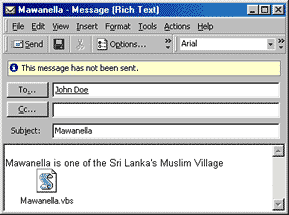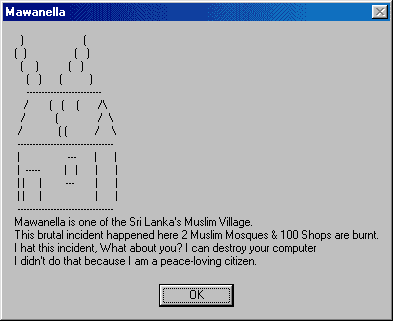Parent class: VirWare
Viruses and worms are malicious programs that self-replicate on computers or via computer networks without the user being aware; each subsequent copy of such malicious programs is also able to self-replicate. Malicious programs which spread via networks or infect remote machines when commanded to do so by the “owner” (e.g. Backdoors) or programs that create multiple copies that are unable to self-replicate are not part of the Viruses and Worms subclass. The main characteristic used to determine whether or not a program is classified as a separate behaviour within the Viruses and Worms subclass is how the program propagates (i.e. how the malicious program spreads copies of itself via local or network resources.) Most known worms are spread as files sent as email attachments, via a link to a web or FTP resource, via a link sent in an ICQ or IRC message, via P2P file sharing networks etc. Some worms spread as network packets; these directly penetrate the computer memory, and the worm code is then activated. Worms use the following techniques to penetrate remote computers and launch copies of themselves: social engineering (for example, an email message suggesting the user opens an attached file), exploiting network configuration errors (such as copying to a fully accessible disk), and exploiting loopholes in operating system and application security. Viruses can be divided in accordance with the method used to infect a computer:- file viruses
- boot sector viruses
- macro viruses
- script viruses
Class: Email-Worm
Email-Worms spread via email. The worm sends a copy of itself as an attachment to an email message or a link to its file on a network resource (e.g. a URL to an infected file on a compromised website or a hacker-owned website). In the first case, the worm code activates when the infected attachment is opened (launched). In the second case, the code is activated when the link to the infected file is opened. In both case, the result is the same: the worm code is activated. Email-Worms use a range of methods to send infected emails. The most common are: using a direct connection to a SMTP server using the email directory built into the worm’s code using MS Outlook services using Windows MAPI functions. Email-Worms use a number of different sources to find email addresses to which infected emails will be sent: the address book in MS Outlook a WAB address database .txt files stored on the hard drive: the worm can identify which strings in text files are email addresses emails in the inbox (some Email-Worms even “reply” to emails found in the inbox) Many Email-Worms use more than one of the sources listed above. There are also other sources of email addresses, such as address books associated with web-based email services.Read more
Platform: VBS
Visual Basic Scripting Edition (VBScript) is a scripting language interpreted by Windows Script Host. VBScript is widely used to create scripts on Microsoft Windows operating systems.Description
Technical Details
This Internet worm spreads via e-mail messages using MS Outlook. The worm is written in Visual Basic Script language (VBS) and spreads as a "Mawanella.vbs" file attached to an e-mail message.
This is a typical Loveletter-like VBS worm; however, it is encrypted (encoded) to bypass heuristic scanners.
This worm spreads via e-mail by sending infected messages from infected computers. While spreading, the worm uses MS Outlook, and sends itself to all addresses that are stored in the MS Outlook Address Book. As a result, an infected computer sends as many messages to as many addresses that are kept in the MS Outlook contacts list.
It works only on computers on which the Windows Scripting Host (WSH) is installed. In Windows 98 and Windows 2000, WHS is installed by default. To spread itself, the worm accesses MS Outlook and uses its functions and address lists. This is available in Outlook 98/2000 only, so the worm is able to spread only in the case that one of these MS Oulook versions is installed.
The infected message in the original worm version appears as follows:
Subject = "Mawanella"
Body = "Mawanella is one of the Sri Lanka's Muslim Village"
Attached file name = "Mawanella.vbs"

If a computer doesn't have MS Outlook installed, the worm simply displays a message:
Please Forward this to everyone
After spreading, the worm displays the following message:

The worm doesn't mark infected computers in any way, thus it will send infected messages each time a user activates the worm's VBS file.
Read more
Find out the statistics of the vulnerabilities spreading in your region on statistics.securelist.com